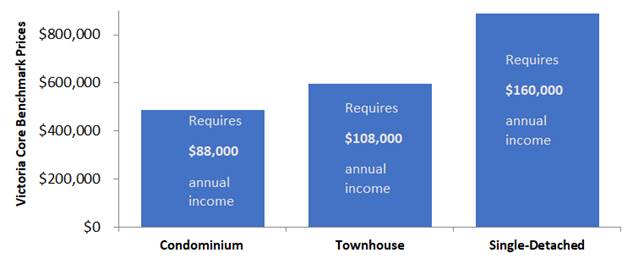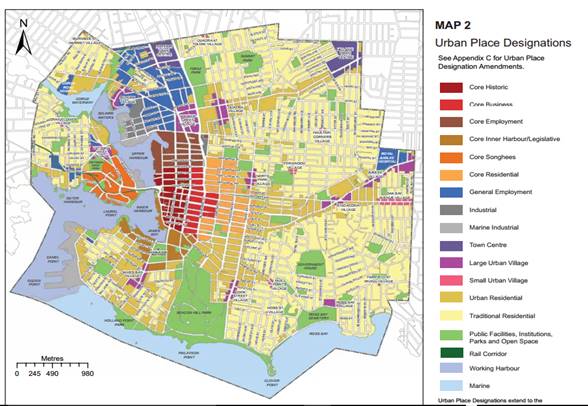Conventional planning is static, designed to lock in existing land use patterns. We need more dynamic planning to respond to changing household needs and community goals.

My recent column, "Affordability Trade-offs," advocated a broad definition of affordability that considers middle- as well as low-income households, transportation as well as housing costs, plus future as well as current cost impacts. A subsequent column, "How Filtering Increases Housing Affordability," described how building more middle-priced housing tends to increase affordability through filtering, as some lower-priced housing occupants move into more expensive units, and over time as the new houses depreciate and become cheaper. This column describes how to our planning practices to support affordable and inclusive infill development.
An old friend once described an incident in an urban neighborhood ladies tea party during the late 1970s. By then, the area was well integrated, so the group was mixed-race, but one confused elderly woman observed proudly, “Well, we sure kept the Blacks out of here, didn’t we!” She evidently assumed that everybody else there shared her preferences for an exclusive neighborhood.
Few people would now use such explicitly racist language, but many conventional planning practices, such as minimal lot sizes, density restrictions, and prohibitions on multi-family housing, are still intended to exclude lower-income households from desirable neighborhoods. Fairness and opportunity require reforming these policies.
Conventional planning is static, designed to lock-in existing land use patterns. To be efficient and equitable, land market must respond to changing consumer needs and community goals. For example, if the number of people who want to live in a neighborhood increases, or a community wants to become more affordable and inclusive, responsive development policies allow higher densities and more affordable housing types. Similarly, if a community wants to become healthier and less polluting, it must plan for better walking, bicycling, and public transit services. In fact, consumer surveys indicate that a growing majority of households want to live in walkable urban neighborhoods, but many cannot due to inadequate housing supply and high costs. Virtually everybody benefits if more low- and moderate-income households can find suitable housing in such areas.
Responding to these changing needs and goals requires dynamic planning. This is our realm: planners are professional change managers. It is up to us to identify specific policies and planning reforms that respond to changing needs.
Planning for More Affordability
A useful starting point for more affordable and inclusive planning is to understand the factors that affect housing development costs, and therefore the housing types that are most affordable. Single-family housing is land intensive, typically requiring three to six times as much land as a townhouse, and about ten times as much as a low-rise apartment. High rise buildings are costly to construct. In most situations the most affordable housing types are low-rise (two to six story) carriage houses, multi-plexes (e.g., duplexes and four-plexes), townhouses, live/work lofts, residential above commercial, and courtyard apartments, often called the missing middle, as illustrated below.

To evaluate the affordability impacts of missing middle housing I calculated the minimum incomes required to pay mortgages on the median prices of condominiums, townhouses and single-detached houses in my city, Victoria, British Columbia, assuming that households can spend up to 30% of their budget on mortgages.
Typical Housing Prices and Income Requirements

When somebody says, “I only want detached houses in my neighbourhood,” they are essentially saying, “I only want households earning more than $160,000 in my neighbourhood.” Of course, these costs may vary, but in virtually any community single-detached homes require far higher incomes than more compact housing types.
Many current policies discourage development of affordable housing types. For example, most urban neighborhoods only allow low-rise (two story) houses (yellow in the map below), and require one or more parking spaces per housing unit, which significantly increases development costs in areas with high land prices.
Victoria Development Regulations

Most land suitable for residential development in Victoria (excluding parks and industrial areas) is restricted to two-story houses (light yellow in the map), and require at least one parking space per housing unit. These regulations drive up their costs and reduce affordability.
There are many possible ways to increase affordability. Some provide large benefits to small number of households that qualify for special services (often those with the greatest needs, such as people with disabilities or very low incomes), while others provide smaller benefits to a larger number of low- and moderate-income households. Some policies depend on subsidies, others reduce the costs of developing moderate-priced housing. Transportation affordability is also important. An inexpensive house is not really affordable if located in a sprawled, automobile-dependent area with high transportation costs. Walking, cycling, ridesharing and public transit are affordable modes – improving them allows households to reduce their vehicle costs and save money.
Below are specific local policies that can increase housing and transportation affordability.
- Establish affordable housing programs which determine affordable housing needs and identify ways to respond to those needs.
- Establish affordable infill housing develoment targets. For example, Victoria’s population currently grows about 1.5% annually. To become more affordable and diverse we must increase our housing supply faster than that rate. A reasonable target is for residential neighborhoods to increase housing supply at least 1.5% annually, which we call the 1.5% Neighborhood Affordability Solution [pdf]. Most of these new houses should be moderately priced ($300,000-600,000), so they are initially affordable to middle-income households and becomes affordable to the lower-income households as they depreciate.
- Remove barriers to the development of low- and moderated-priced infill housing, such as unjustified minimum parcel and unit sizes, limits on building heights, restrictions on multi-family housing and secondary suites, setback requirements, and unjustified fees and impact studies.
- Increase allowable housing densities and heights. Entire neighborhoods or land use types can be upzoned, or changes can be more incremental:
- Change “single-family” into “residential” zoning to allow multi-plexes (two or more units under one roof), townhouses and low-rise apartments in neighborhoods that currently only allow detached single-family houses.
- Increase allowable densities, building heights, floor area ratios (FARs), and allowable uses, based on a time schedule (e.g., a 10% annual increase), or a performance target, such as when housing prices exceed a threshold.
- Allow taller buildings and higher densities on corner and larger lots, which minimizes impacts on neighbours. For example, a neighborhood that currently allows only two-story homes would allow three stories on corner lots, plus one additional story for each 10,000 square feet (approximately a quarter acre), so a 6,000 square foot corner lot may be up to three stories, and a 10,000 square foot corner lot may be up to four stories.
- Allow new buildings to be up to 1.5 times higher than existing adjacent buildings. For example, if existing homes are two stories, adjacent new homes may be three.
- Allow taller buildings along collectors (typically up to four stories) and arterials (typically up to six stories).
- Automatically increase the allowable heights of single-family parcels adjacent to a commercial development by one story, and allow conversion to multi-family on these parcels after a time period, such as ten years.
- Significantly reduce or eliminate minimum parking requirements for lower-priced housing in walkable urban neighbourhoods. Note, this does not mean that all new houses would have no parking, it simple lets developers decide the number of parking spaces to provide based on consumer demand. Develop parking management programs to encourage more efficient use of parking facilities and address potential spillover problems (motorists parking where they should not). Require landlords to unbundle parking (rent parking separately from housing) so occupants are not forced to pay for parking spaces they do not need.
- Allow higher densities and greater heights in exchange for more affordable housing units. It some cases municipal governments can require minimum building density and height in accessible locations, for example, at least three stories along minor arterials and four stories along major arterials.
- Support and subsidize social housing development, including special housing to accommodate people with disabilities, and housing cooperatives that provide moderate-priced “workforce” housing.
- Improve affordable housing design. Municipal governments can support contests, planning charrettes and workshops to encourage better design. Websites such as the Affordable Housing Design Advisor, the Missing Middle, and Portland’s Infill Design Project provide resources for improving lower-priced housing design.
- In areas with affordable housing shortages and rapid housing development, apply inclusionary zoning, in which developers must sell or rent a portion of units (usually 5-15%) below market prices.
- Where there is a shortage of rental housing, support rental housing development, and reform policies that favour home ownership over renting.
- Expedite development approvals and reduce development fees for smaller and lower-priced projects. For example, reduce the number of public hearings, and eliminate traffic impact study requirements, for projects with fewer than 20 units, at least half of which are affordable to median-income households.
- Improve sidewalks, crosswalks, paths and bike lanes, and reduce traffic speeds where needed to ensure that walking and cycling are comfortable and safe.
- Support lower-cost mobility options such as carsharing, bikesharing, and ridesharing services.
- Improve public transit services, particularly in lower-income neighbourhoods and other areas with many car-free households.
- Establish complete streets policies, so all streets are designed to accommodate diverse uses and users.
- Support Smart Growth development policies that support affordable housing development in walkable urban neighbourhoods.
Risks and Trade Offs
Some affordable housing strategies may have unintended consequences: they may increase affordability for some households but reduce affordability for others, or in other ways, fail to achieve their goals.
For example, a rent subsidy for a particular group, such as people with disabilities or seniors, will increase affordability for recipients, but can cause rent inflation by allowing some households to pay more for desirable units, and so displace households that do not qualify. Only if the total supply of the desired housing increases, such as more lower-priced apartments in walkable urban neighbourhoods, can all households find suitable housing.
Subsidies and inclusionary zoning policies may increase affordability for the households selected to receive below-market housing, but such programs can usually only serve a small portion of affordable housing demands, and they can reduce total housing development, particularly moderate-price housing.
Inclusionary zoning can be successful in areas with very strong housing demand so developers always build as many units as regulations allow, but if demand is weaker they build fewer units [pdf], particularly moderate priced units, resulting in less affordable future housing supply. For example, if basic housing units costs $200,000 to build, and regulations require 10% be priced at $100,000, each of the nine market-priced units bears an additional $11,111 ($100,000/9) cost, which adds about $20,000 to their final price, including additional overhead and financing costs. This is a small increase for high-priced housing (2% for a million dollar house) but a large increase for lower-priced housing (11% for a $200,000 condominium). In this way, inclusionary zoning can reduce housing affordability, particularly over the long run, by reducing construction of moderately-priced housing that contributes to future affordable housing stock.
Similarly, regulations that limit rent increases can increase existing residents’ affordability, but by reducing profitability discourage new rental housing development which will reduce the future supply of affordable rental housing.
The strategies that tend to provide the greatest total affordable benefits reduce infill development construction costs. These increase the affordability of both for-profit housing and the number of units that can be built by non-profit development agencies. For example, a million dollar subsidy could only create about five affordable single-family suburban houses, but ten to twenty affordable urban apartment units with unbundled parking.
For more information
Bob Bengford (2017), Visualizing Compatible Density, Municipal Research and Services Center.
Alex Cecchini (2015), Barriers to Small Scale Infill Development, Streets MN.
Cities for Everyone (2018), Victoria Affordability Backgrounder
Housing Affordability and Livability Agenda is a City of Seattle program to create more affordable and inclusive neighborhoods.
Sanford Ikeda and Emily Washington (2015), How Land-Use Regulation Undermines Affordable Housing, Mercatus Center at George Mason University.
Rick Jacobus (2016), Why We Must Build; We Can’t Build Our Way Out Of The Housing Crisis … But We Won’t Get Out Without Building, Shelterforce.
Legalizing Inexpensive Housing is a Sightline Institute series which examines how public policies can support more affordable housing development.
Todd Litman (2017), Affordable Accessible Housing in a Dynamic City, Victoria Transport Policy Institute.
Local Housing Solutions provides resources to help local governments develop comprehensive and balanced housing strategies that enhance affordability, prevent displacement and foster inclusive neighborhoods.
Making Room Vancouver is the City of Vancouver’s program to create more affordable and inclusive neighborhoods.
Sara Maxana (2016), YIMBY Keynote Speech, Yes In My Backyard Conference.
Dan Parolek (2014), Missing Middle Housing: Responding To Demand for Walkable Urban Living, Opticos Design/Missing Middle.
Portland (2014), Infill Design Project, Portland Bureau of Planning and Sustainability.
Mac Taylor (2016), Perspectives on Helping Low-Income Californians Afford Housing, Legislative Analyst’s Office.

Planetizen Federal Action Tracker
A weekly monitor of how Trump’s orders and actions are impacting planners and planning in America.

Chicago’s Ghost Rails
Just beneath the surface of the modern city lie the remnants of its expansive early 20th-century streetcar system.

Amtrak Cutting Jobs, Funding to High-Speed Rail
The agency plans to cut 10 percent of its workforce and has confirmed it will not fund new high-speed rail projects.

Ohio Forces Data Centers to Prepay for Power
Utilities are calling on states to hold data center operators responsible for new energy demands to prevent leaving consumers on the hook for their bills.

MARTA CEO Steps Down Amid Citizenship Concerns
MARTA’s board announced Thursday that its chief, who is from Canada, is resigning due to questions about his immigration status.

Silicon Valley ‘Bike Superhighway’ Awarded $14M State Grant
A Caltrans grant brings the 10-mile Central Bikeway project connecting Santa Clara and East San Jose closer to fruition.
Urban Design for Planners 1: Software Tools
This six-course series explores essential urban design concepts using open source software and equips planners with the tools they need to participate fully in the urban design process.
Planning for Universal Design
Learn the tools for implementing Universal Design in planning regulations.
Caltrans
City of Fort Worth
Mpact (founded as Rail~Volution)
City of Camden Redevelopment Agency
City of Astoria
City of Portland
City of Laramie




























